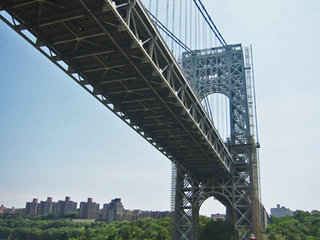www.aljazeerah.info
Opinion Editorials, June 2018
Archives
Mission & Name
Conflict Terminology
Editorials
Gaza Holocaust
Gulf War
Isdood
Islam
News
News Photos
Opinion Editorials
US Foreign Policy (Dr. El-Najjar's Articles)
www.aljazeerah.info
Black Stone, Black Rock, or a Public Bank? Putting California's Funds to Work By Ellen Brown Al-Jazeerah, CCUN, June 4, 2018 |
 |
 |
|
California has over $700 billion parked in private banks earning minimal interest, private equity funds that contributed to the affordable housing crisis, or shadow banks of the sort that caused the banking collapse of 2008. These funds, or some of them, could be transferred to an infrastructure bank that generated credit for the state – while the funds remained safely on deposit in the bank.
California needs over $700 billion in infrastructure during the next decade. Where will this money come from? The $1.5 trillion infrastructure initiative unveiled by President Trump in February 2018 includes only $200 billion in federal funding, and less than that after factoring in the billions in tax cuts in infrastructure-related projects. The rest is to come from cities, states, private investors and public-private partnerships (PPPs) one. And since city and state coffers are depleted, that chiefly means private investors and PPPs, which have a shady history at best.
A 2011 report by the Brookings Institution found that “in practice [PPPs] have been dogged by contract design problems, waste, and unrealistic expectations.” In their 2015 report “Why Public-Private Partnerships Don’t Work,” Public Services International stated that “experience over the last 15 years shows that PPPs are an expensive and inefficient way of financing infrastructure and divert government spending away from other public services. They conceal public borrowing, while providing long-term state guarantees for profits to private companies.” They also divert public money away from the neediest infrastructure projects, which may not deliver sizable returns, in favor of those big-ticket items that will deliver hefty profits to investors. A March 2017 report by the Economic Policy Institute titled “No Free Bridge” also highlighted the substantial costs and risks involved in public-private partnerships and other “innovative” financing of infrastructure.
Meanwhile, California is far from broke. It has over well over $700 billion in funds of various sorts tucked around the state, including $500 billion in CalPERS and CalSTRS, the state’s massive public pension funds. These pools of money are restricted in how they can be spent and are either sitting in banks drawing a modest interest or invested with Wall Street asset managers and private equity funds that are not obligated to invest the money in California and are not safe. For fiscal year 2009, CalPERS and CalSTRS reported almost $100 billion in losses from investments gone awry.
In 2017, CalSTRS allocated $6.1 billion to private equity funds, real estate managers, and co-investments, including $400 million to a real estate fund managed by Blackstone Group, the world’s largest private equity firm, and $200 million to BlackRock, the world’s largest “shadow bank.” CalPERS is now in talks with BlackRock over management of its $26 billion private equity fund, with discretion to invest that money as it sees fit.
“Private equity” is a rebranding of the term “leveraged buyout,” the purchase of companies with loans which then must be paid back by the company, typically at the expense of jobs and pensions. Private equity investments may include real estate, energy, and investment in public infrastructure projects as part of a privatization initiative. Blackstone is notorious for buying up distressed properties after the housing market collapsed. It is now the largest owner of single-family rental homes in the US. Its rental practices have drawn fire from tenant advocates in San Francisco and elsewhere, who have called it a Wall Street absentee slumlord that charges excessive rents, contributing to the affordable housing crisis; and pension funds largely contributed the money for Blackstone’s purchases.
BlackRock, an offshoot of Blackstone, now has $6 trillion in assets under management, making it larger than the world’s largest bank (which is in China). Die Zeit journalist Heike Buchter, who has written a book in German on it, calls BlackRock the “most powerful institution in the financial system” and “the most powerful company in the world” – the “secret power.” Yet despite its size and global power, BlackRock, along with Blackstone and other shadow banking institutions, managed to escape regulation under the Dodd-Frank Act. Blackstone CEO Larry Fink, who has cozy relationships with government officials according to journalist David Dayen, pushed hard to successfully resist the designation of asset managers as systemically important financial institutions, which would have subjected them to additional regulation such as larger capital requirements.
The proposed move to hand CalPERS’ private equity fund to BlackRock is highly controversial, since it would cost the state substantial sums in fees (management fees took 14% of private equity profits in 2016), and BlackRock gives no guarantees. In 2009, it defaulted on a New York real estate project that left CalPERS $500 million in the hole. There are also potential conflicts of interest, since BlackRock or its managers have controlling interests in companies that could be steered into deals with the state. In 2015, the company was fined $12 million by the SEC for that sort of conflict; and in 2015, it was fined $3.5 million for providing flawed data to German regulators. BlackRock also puts clients’ money into equities, investing it in companies like oil company Exxon and food and beverage company Nestle, companies which have been criticized for not serving California’s interests and exploiting state resources.
California public entities also have $2.8 billion in CalTRUST, a fund managed by BlackRock. The CalTRUST government fund is a money market fund, of the sort that triggered the 2008 market collapse when the Reserve Primary Fund “broke the buck” on September 15, 2008. The CalTRUST website states:
You could lose money by investing in the Fund. Although the Fund seeks to preserve the value of your investment at $1.00 per share, it cannot guarantee it will do so. An investment in the Fund is not insured or guaranteed by the Federal Deposit Insurance Corporation or any other government agency. The Fund’s sponsor has no legal obligation to provide financial support to the Fund, and you should not expect that the sponsor will provide financial support to the Fund at any time.
CalTRUST is billed as providing local agencies with “a safe, convenient means of maintaining liquidity,” but billionaire investor Carl Icahn says this liquidity is a myth. In a July 2015 debate with Larry Fink on FOX Business Network, Icahn called BlackRock “an extremely dangerous company” because of the prevalence of its exchange-traded fund (ETF) products, which Icahn deemed illiquid. “They sell liquidity,” he said. “There is no liquidity. . . . And that’s what’s going to blow this up.” His concern was the amount of money BlackRock had invested in high-yield ETFs, which he called overpriced. When the Federal Reserve hikes interest rates, investors are likely to rush to sell these ETFs; but there will be no market for them, he said. The result could be a run like that triggering the 2008 market collapse.
The Infrastructure Bank Option
There is another alternative. California’s pools of idle funds cannot be spent on infrastructure, but they could be deposited or invested in a publicly-owned bank, where they could form the deposit base for infrastructure loans. California is now the fifth largest economy in the world, trailing only Germany, Japan, China and the United States. Germany, China and other Asian countries are addressing their infrastructure challenges through public infrastructure banks that leverage pools of funds into loans for needed construction.
Besides the China Infrastructure Bank, China has established the Asian Infrastructure Investment Bank (AIIB), whose members include many Asian and Middle Eastern countries, including Australia, New Zealand, and Saudi Arabia. Both banks are helping to fund China’s trillion dollar “One Belt One Road” infrastructure initiative.
Germany has an infrastructure bank called KfW which is larger than the World Bank, with assets of $600 billion in 2016. Along with the public Sparkassen banks, KfW has funded Germany’s green energy revolution. Renewables generated 41% of the country’s electricity in 2017, up from 6% in 2000, earning the country the title “the world’s first major green energy economy.” Public banks provided over 72% of the financing for this transition.
As for California, it already has an infrastructure bank – the California Infrastructure and Development Bank (IBank), established in 1994. But the IBank is a “bank” in name only. It cannot take deposits or leverage capital into loans. It is also seriously underfunded, since the California Department of Finance returned over half of its allotted funds to the General Fund to repair the state’s budget after the dot.com market collapse. However, the IBank has 20 years’ experience in making prudent infrastructure loans at below municipal bond rates, and its clients are limited to municipal governments and other public entities, making them safe bets underwritten by their local tax bases. The IBank could be expanded to address California’s infrastructure needs, drawing deposits and capital from its many pools of idle funds across the state.
A Better Use for Pension Money
In an illuminating 2017 paper for UC Berkeley’s Haas Institute titled “Funding Public Pensions,” policy consultant Tom Sgouros showed that the push to put pension fund money into risky high-yield investments comes from a misguided application of the accounting rules. The error results from treating governments like private companies that can be liquidated out of existence. He argues that public pension funds can be safely operated on a pay-as-you-go basis, just as they were for 50 years before the 1980s. That accounting change would take the pressure off the pension boards and free up hundreds of billions of dollars in taxpayer funds. Some portion of that money could then be deposited in publicly-owned banks, which in turn could generate the low-cost credit needed to fund the infrastructure and services that taxpayers expect from their governments.
Note that these deposits would not be spent. Pension funds, rainy day funds and other pools of government money can provide the liquidity for loans while remaining on deposit in the bank, available for withdrawal on demand by the government depositor. Even mainstream economists now acknowledge that banks do not lend their deposits but actually create deposits when they make loans. The bank borrows as needed to cover withdrawals, but not all funds are withdrawn at once; and a government bank can borrow its own deposits much more cheaply than local governments can borrow on the bond market. Through their own public banks, government entities can thus effectively borrow at bankers’ rates plus operating costs, cutting out middlemen. And unlike borrowing through bonds, which merely recirculate existing funds, borrowing from banks creates new money, which will stimulate economic growth and come back to the state in the form of new taxes and pension premiums. A working paper published by the San Francisco Federal Reserve in 2012 found that one dollar invested in infrastructure generates at least two dollars in GSP (state GDP), and roughly four times more than average during economic downturns.
___________
This article was originally published on Truthdig.com. Ellen Brown is an attorney, chairman of the Public Banking Institute, and author of twelve books including Web of Debt and The Public Bank Solution. Her 300+ blog articles are posted at EllenBrown.com.
***
Share the link of this article with your facebook friends
|
|
|
|
||
|
||||||


